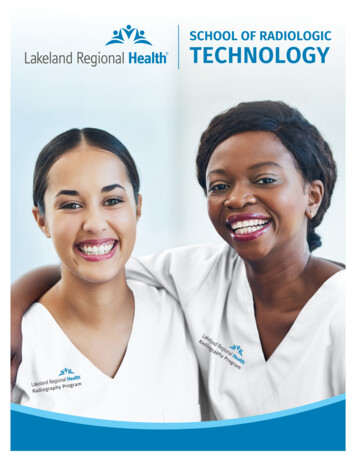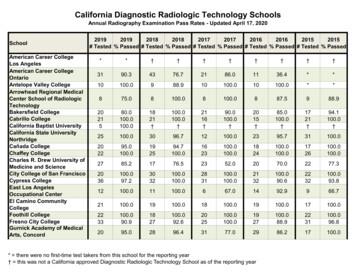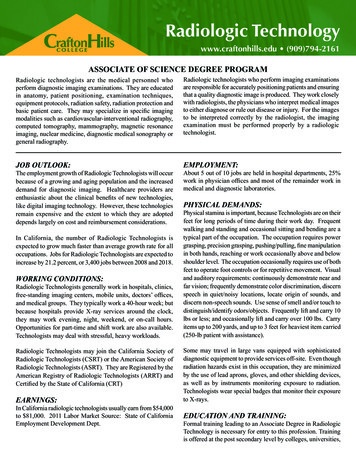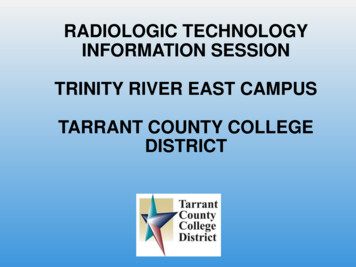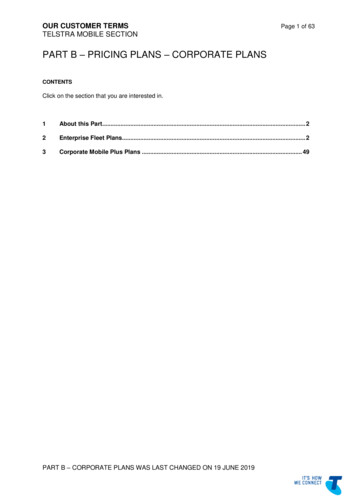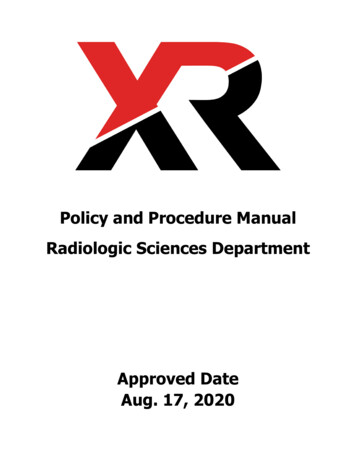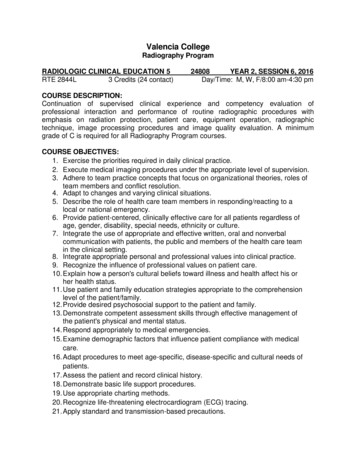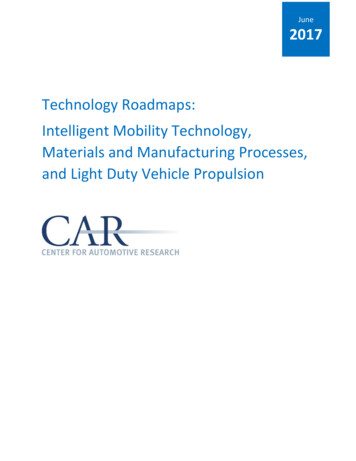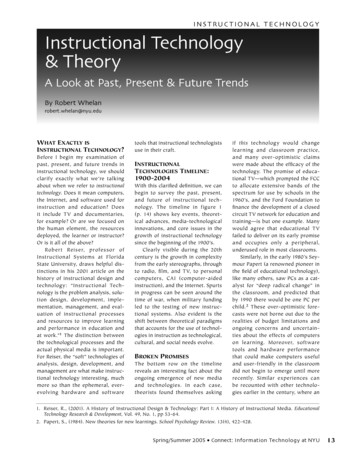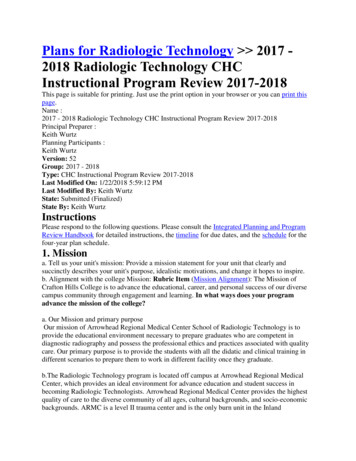
Transcription
Plans for Radiologic Technology 2017 2018 Radiologic Technology CHCInstructional Program Review 2017-2018This page is suitable for printing. Just use the print option in your browser or you can print thispage.Name :2017 - 2018 Radiologic Technology CHC Instructional Program Review 2017-2018Principal Preparer :Keith WurtzPlanning Participants :Keith WurtzVersion: 52Group: 2017 - 2018Type: CHC Instructional Program Review 2017-2018Last Modified On: 1/22/2018 5:59:12 PMLast Modified By: Keith WurtzState: Submitted (Finalized)State By: Keith WurtzInstructionsPlease respond to the following questions. Please consult the Integrated Planning and ProgramReview Handbook for detailed instructions, the timeline for due dates, and the schedule for thefour-year plan schedule.1. Missiona. Tell us your unit's mission: Provide a mission statement for your unit that clearly andsuccinctly describes your unit's purpose, idealistic motivations, and change it hopes to inspire.b. Alignment with the college Mission: Rubric Item (Mission Alignment): The Mission ofCrafton Hills College is to advance the educational, career, and personal success of our diversecampus community through engagement and learning. In what ways does your programadvance the mission of the college?a. Our Mission and primary purposeOur mission of Arrowhead Regional Medical Center School of Radiologic Technology is toprovide the educational environment necessary to prepare graduates who are competent indiagnostic radiography and possess the professional ethics and practices associated with qualitycare. Our primary purpose is to provide the students with all the didatic and clinical training indifferent scenarios to prepare them to work in different facility once they graduate.b.The Radiologic Technology program is located off campus at Arrowhead Regional MedicalCenter, which provides an ideal environment for advance education and student success inbecoming Radiologic Technologists. Arrowhead Regional Medical Center provides the highestquality of care to the diverse community of all ages, cultural backgrounds, and socio-economicbackgrounds. ARMC is a level II trauma center and is the only burn unit in the Inland
Empire. The Radiologic Technology program supports the Crafton Hills College Missionstatement of advancing the education and provide personal success in a diverse communitythrough engagement and learning because it provides students the opportunity to engage in handson learning. As an example students in the Radiologic Technology program have the opportunityto care for patients who are severly injured and/or patients who got burned.2. Description of Programa. Organizational Structure and Staffingb. Describe any activities in addition to instruction that you provide.c. Describe any alternative modes of instruction and schedules of delivery: e.g.: online, hybrid,early morning, evening services.d. Rubric Item: Describe how your curriculum is up-to-date and Needs-Based. Base thedescription on surveys, labor market data, transfer patterns such as GE, IGETC, CSU, AA-T, orAS-T, accreditation standards, and/or articulation agreements. Consider the results of your mostrecent curriculum reviews in this section.e. Rubric Item: Attach your scheduling matrix to show when courses in your area are offered.Click here for sample!a. Organization (including staffing and structure)HA M. LE,M.D. , Medical Director (2011), Melisa Huynh, M.S.R.S, RT(R),CRT, ProgramDirector (July 2017); Debra Anderson, BS., RT(R), CRT, Clinical Coordinator (2012).b. The additional activities to instruction that ARMC School of Radiologic Technology provideto the students is the opportunity to observe in different modalities. The different modalitesincludes CT, MRI, Nuclear Medicine, Ultrasound, Radiation Theraphy, Interventional andCardiac Radiography. The students also have the opportunity to participate in the ACERT(Association of Collegiate Educators in Radiologic Technology) Conference in Las Vegas. Atthe ACERT conference, students participate in the student challege bowl. The studentchallenge bowl consists of mock review board questions. This competition is challengedamongst other programs which consisted of about 500 to 600 students.c. The other mode of instruction that ARMC School of Radiologic Technology provide are theonline portion, which comes along with the RADIOL 208 and RADIOL 215 book. The bookprovide a code where the student can log into an account and access a list of mock review boardquestions. These mock review board questions gives the students an insight of what might be onthe national board exam. Other than the online portion from the book, our program from time totime, use Kahoots during class time. Kahoots is an online learning game, where instructors areable to create their own questions to challege the students. This game is very engaging for thestudents to learn the material.d. Rubric Item:Currently the curriculum is not up-to-date and there is no evidence showing the needs-based dueto a change of faculty member whom started in July of 2017, however, we are in the process ofupdating the curriculum, which is updated annually. The curriculum should be updated andapproved by Fall 2018. ARMC School of Radiologic Technology uses student surveys andevaluations every semester, as well as faculty surveys to evaluate for necessary changes. We alsocollect post-graduate surveys and employers surveys to stay current in order to provide the needsof the community.The datas are then reported to The Joint Review Committee on Education inRadiologic Technology (JRCERT). We also use the reports generated from The American
Registry of Radiologic Technologists (ARRT) on graduates performance on the national boardexamination. We utilized those data to make curriculum changes.e. Rubric Item:ARMC School of Radiologic Technology is a 23 month program. Our students start the programin August and graduate in June. (Please see Scheduling Matrix)3. External Factors with Significant ImpactWhat external factors have a significant impact on your program? Please include the following asappropriate:a. Budgetary constraints or opportunitiesb. Competition from other institutionsc. Requirements of four-year institutionsd. Requirements imposed by regulations, policies, standards, and other mandatese. Job marketi) Requirements of prospective employersii) Developments in the field (both current and future)a. Budgetary constraints or opportunitiesThe County of San Bernardino sponsors and financially supports the program at ArrowheadRegional Medical Center (ARMC). The budget is adequate to cover the expense of operating theprogram. The program also receives financial support from Crafton Hills College for specialpurchases. The program director would state the need for the program at the time the departmentbudget is being formulated. As other needs are encountered during the fiscal year, they arepresented to the department manager. Funding is provided within the limitations of the MedicalImaging and Hospital budgets. Perkins funds are available for only limited specified support inthe program.b. Competition from other institutionsWithin sixty miles from ARMC School of Radiologic Technology, there are eleven RadiologicTechnology program. The other programs are from California Baptist University, Loma LindaUniversity, Chaffey Community College, Charles R. Drew University of Medicine and Science,Cypress College, East Los Angeles Occupational Center, Long Beach City College, Los AngelesCity College, Mt. San Antonio College, Orange Coast College, and Pasadena City College.Amongst other institutions offering Radiologic Technology programs, ARMC School ofRadiologic Technology is the only Hospital Based program.c. Requirements of four-year institutionsOur program and students articulate well with Loma Linda University, Cal State Northridge,andother Universities offering BS degrees in Medical Imaging, Radiologist Assistant and HealthCare Administration.d. Requirements imposed by regulations, policies, standards, and other mandatesThe Joint Review Committee on Education in Radiologic Technology (JRCERT) requires theprogram to be in compliance with "Standards for Accredited Educational Program inRadiography". "The Joint Review Committee on Education in Radiologic Technology isdedicated to excellence in education and to the quality and safety of patient care through the
accreditation of educational programs in the radiologic sciences". The JRCERT is the onlyagency recognized by the United States Department of Education and the Council on HigherEducation Accreditration for the accreditation of traditional and distance delivery educationalprograms in radiography, radiation, therapy, magnetic resonance, and medical dosimetry. TheJRCERT awards accreditation to programs demonstration substantial compliance with theseSTANDARDS: Integrity, Resources,Curriculum and Academic Practices, Health and Safety,Assessment, and Institutional/ Programmatic Data.e. Job marketi) Requirements of prospective employersThe Joint Review Committee on Education in Radiologic Technology (JRCERT) requires theprogram to report results of employer satisfaction surveys.ii) Developments in the field (both current and future)The employment growth of Radiologic Technologists will occur because of a growing and agingpopulation and the increased demand for diagnostic imaging. Healthcare providers areenthusiastic about the clinical benefits of new and improved technologies such as digitalimaging, computerized Axial Tomography(CT), Magnetic Resonance Imaging (MRI) etc. InCalifornia, the number of Radiologic Technologists is expected to grow faster than the averagegrowth rate for all occupations. Jobs for Radiologic Technologists are expected to increase 9percent from 2014 to 2024, faster than the average for all occupations. In 2014 there are 197,000radiologic technologists jobs which is expected to increase to 214,200 jobs in 2024. The medianannual wage for radiologic technologists was 57,450 in May 2016. This information is from theU.S. Bureau of Labor Statistics. Since Medical Imaging is constantly changing due totechnology. Our program must prepare our students for current and future advancements inMedicalImaging.4. Progress on Outcomes Assessment (Four-Year Question)Refer to the SLO Cloud to evaluate the results from your program level outcomes and to developactions reflected in your program review action plan (i.e. Question 10). Rubric Item: ProgramLearning Outcomesa. Please summarize Program Level Outcomes (PLO) assessment results. Include a discussionof whether or not the program met its target for each PLO.b. Please describe any program/course and/or instructional improvements you plan to make as aresult of the PLO assessment(s).c. What objective(s) or action step(s) will you add to Question 10 as a result of the PLOassessment(s)? If none, please explain.Our SLOs have been defined, assessed, evaluated, and have consistently been used to informinstruction.a. Please summarize Program Level Outcomes (PLO) assessment results. Include a discussionof whether or not the program met its target for each PLO.Our SLOs are reported on SLO Cloud, which are defined by the Joint Review Committee onEducation in Radiologic Technology (JRCERT). Our SLOs are determined by the profession'sclinical guidelines and standards. We addressed the SLOs in our faculty and advisory meetingson a regular basis. We also review the National test scores provided by the American Registry ofRadiologic Technologists (ARRT) according to the exam matrix. Our program overall, has met
the target except for two PLOs. These two Outcomes were based on Employer's survey of ourrecent graduates. Utilizing this data and based on our observations and interpretations, we cameup with an idea of increasing the mandatory competency sign off list.b. Please describe any program/course and/or instructional improvements you plan to make as aresult of the PLO assessment(s).Based up the PLO assessments, the program has decided to add two more mandatoryprocedures to the competency list, which are given by the American Registry of RadiologicTechnologists (ARRT). The competency list was updated by the ARRT in 2017 which required10 mandatory general patient care activities, thirty-seven mandatory imaging procedures, fifteenelective imaging procedures, one of the fifteen head work, and two of the fifteeen of thefluoroscopy exam. The two added mandatory procedures are from the head work section. Thisdecision will help increase future employer's satisfaction.c. The objective(s) or action step(s) that are added to Question 10 as a result of a the PLOassessment(s) were:1. adding additional mandatory procedures2. add a clinical site3. written test to increase student completion and success rate4. add 24 observation hours to the selection process5. may change prerequisite course to ANAT 150 instead of ANAT 101 to increase success rate5. Unit's Performance on Institutional QuantitativeEffectiveness IndicatorsPlease discuss your program’s performance on each data item below.a. Instructional Program Health Evaluation Rubrici) Rubric Item: Use Office of Institutional Effectiveness, Research, and Planning (OIERP)data to set a Course Completion Rate target and provide an explanation for the target thathas been set. Click HERE to access your program specific data.ii) Rubric Item: Use OIERP data to set a Course Success Rate target and provide anexplanation for the target that has been set. Click HERE to access your program specificdata.iii) Rubric Item: What is your FT/PT Faculty Ratio, how is it impacting your program, andstudent success? Click HERE to access your program specific data.iv) Rubric Item: Use OIERP data to set a WSCH/FTEF Ratio target and provide anexplanation for the target that has been set. Based on Faculty dialogue what is a feasibleWSCH/FTEF (productivity) target for your area? (Note: 525 may not be a realistic target foryour area.) Click HERE to access your program specific data.v) Rubric Item: The Fill rate target is 80% or higher. Use the data provided by the OIERPand please provide a reason for any deviation from the target. This may involve a discussionaround the appropriateness of the cap and how it was set. Click HERE to access yourprogram specific data.i) Rubric Item: Use Office of Institutional Effectiveness, Research, and Planning (OIERP) datato set a Course Completion Rate target and provide an explanation for the target that has beenset.
Course completion rate target is set at 85% because our program have a small cohort. If onestudent withdraws from the program for any reason, we will still meet the target rate. Theaverage five year (2012- 2016) completion rate is 98%.ii) Rubric Item: Use OIERP data to set a Course Success Rate target and provide an explanationfor the target that has been set.Course success rate target is set at 85% because our program have a small cohort. If onestudent does not succeed from the program for any reason, we will still meet the target rate. Theaverage five year (2012 - 2016) success rate is at least 98%.iii) Rubric Item: What is your FT/PT Faculty Ratio, how is it impacting your program, andstudent success?The FT/PT faculty ratio is 0%. Having only part-time faculty who are actually working in thefield provides expertise that's beneficial for student's in the clinical setting.iv) Rubric Item: Use OIERP data to set a WSCH/FTEF Ratio target and provide an explanationfor the target that has been set. Based on Faculty dialogue what is a feasible WSCH/FTEF(productivity) target for your area? (Note: 525 may not be a realistic target for your area.)The WSCH/FTEF ratio target will hold steady at 265 because our program have a small cohort.v) Rubric Item: The Fill rate target is 80% or higher. Use the data provided by the OIERP andplease provide a reason for any deviation from the target. This may involve a discussion aroundthe appropriateness of the cap and how it was set.In 2016-2017, the fill rate was 100% due to adjusting the cap with reduced student enrollments.The program has no issues meeting the 80% target each year.6. Other Unit-Specific Quantitative and Qualitative Resultsa. Rubric Item: How do your program student demographics relate to the collegedemographics? What are the discrepancies? – Click HERE to view program and collegedemographics by year.b. Summarize the results of any quantitative or qualitative measures not provided in the previousquestion that you have chosen to gauge your program’s effectiveness (e.g.: transfers, degrees,certificates, satisfaction, enrollments, Perkin’s data, equity data, student research experience,student clubs, etc.) Click HERE to access your program specific data on degrees andcertificates.c. What improvements/changes have you implemented or do you plan to implement as a result ofyour analysis of the measures illustrated in 6a and 6b?a. Rubric Item: How do your program student demographics relate to the college demographics?What are the discrepancies?The program student demographics is similar to the college demographrics. We have a goodratio of race and ethnicity compared to the college's ratio. The program's students ages rangefrom 20 to 49 compared to the college's students ranging from under 20 to over 50. For theprogram's gender, we have a good blance of male and female compared to the college's genderratio.b. Summarize the results of any quantitative or qualitative measures not provided in the previousquestion that you have chosen to gauge your program's effectiveness (e.g.: transfers, degrees,
certificates, satisfaction, enrollments, Perkin's data, equity data, student research experience,student clubs, etc.)We have seen a steady increase of students earning the AS degrees along with the certificates. In2013 there were 3 students earning the AS degree and in 2017 there were 8 students earning theAS degree. This increase has changed due to the requirement set by the American Registry ofRadiologic Technologists (ARRT).c. What improvements/changes have you implemented or do you plan to implement as a result ofyour analysis of the measures illustrated in 6a and 6b?As of right now there is no plan for implementation, however, it depends if we are able toestablish another clinical site in the future. Based on The Joint Review Committee on Educationin Radiologic Technology (JRCERT) the accreditation body, we are allowed to have a 1:1technologists to student ratio.7. EvaluationEvaluation: You have already provided a description and analysis of the program in questions 16, please provide an analysis of what is going well/not well and why, in the following areas: Alternative modes and schedules of delivery (e.g.: online, hybrid, early morning, eveningservices, etc.) Partnerships (internal and external) Innovation and Implementation of best practices Efficiency in resource use Staffing Participation in shared governance (e.g., do unit members feel they participate effectivelyin planning and decision-making?) Professional development and training Compliance with applicable mandatesWhat is going well: The curriculum structure is going well. The didactic and clinical components are parallel.Students learn principles and concepts in the classroom and apply them immediately in theclinical setting. Students in other programs do not enter into the clinical setting until thesecond semester. The technologists who train the students are graduates of the program and can directlyrelate to the students and become mentors. The program has sufficient resources to support the quality and effectiveness of theeducational process. The program has an adequate number of faculty to meet educational and accreditationrequirements. The faculty participates in professional development and training annually. This includeannual conferences sponsored by the California Society of Radiologic Technologists andthe Association
University, Chaffey Community College, Charles R. Drew University of Medicine and Science, Cypress College, East Los Angeles Occupational Center, Long Beach City College, Los Angeles City College, Mt. San Antonio College, Orange Coast Coll
